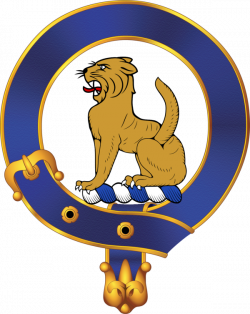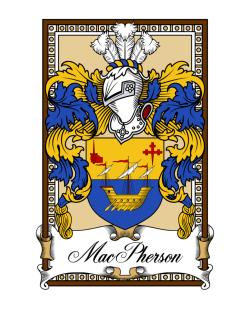
Clan MacPherson
TOUCH NOT THE CAT BUT A GLOVE
Clan MacPherson are a Highland clan, and a member of the historic Chattan Confederation. Clan tradition tells the story that the MacPhersons were awarded the lands of Badenoch by King Robert the Bruce after destroying the sworn enemies of the Bruces, clan Comyn.
Clan chief Euan Macpherson of Cluny was a notable primary figure in the 1745 Jacobite uprising, and managed to evade capture after the Battle of Culloden despite a £1000 bounty on his head. He eventually took refuge in France in 1755.
The MacPherson clan motto is "Touche not le chat bot a glove" (Touch not the cat but a glove) and the clan crest is a sitting wildcat.
Scottish History
of Clan MacPherson
Sons of the parson
The Macpherson clan originated from a Mac a Phearsoin, meaning Son of the Parson. The idea that a man took his name from the son of a clergyman, in the days well before the Reformation, when the church was based solidly on Roman Catholicism is quite possible given the circumstances.
The old Celtic church was frequently responsible for clergy who could marry and, within the ancient and titled families, the role of clergyman was taken up as a matter of right by the sons and relatives of gentry. A lengthy distance from Rome no doubt helped.
So the name, Macpherson must frequently originate from widely, unrelated parts of Scotland, as many would take their name as being son of the parson in that area.
The first to appear on record, though, is one Donald Minpersuyn in 1335. He belonged to the family by the same name associated with the Argyllshire church of St Columba in Glasery. By 1420 another Macpherson was the rector in the same parish: but it is accepted that their chief of the Macpherson Clan, Macpherson of Cluny is descended from the clan Mhuirich in Strathnairn, Strathdearn and Badenoch.
These Macphersons belong to the Clan Chattan, which was a loose association of sixteen clans, descended on either male or female line from a chief called Gillechattan, whom the old Gaelic genealogists trace from Fercharthge Lond, King of Lorn, who died in 697. The Macphersons are supposed to descend from the male line, the Mackintoshes from the female line, although this is not actually proven.
The connection with the parson derives from the Gilliechattan; he is referred to as a cleric, and his progeny are mentioned as hereditary lay clergy of the areas around Kingussie. One of them, Duncan, son of Kenneth appears in 1438 as Duncan of the Parson. From him the chief of the Clan Vuireach takes the name of Macpherson.
This Duncan the parson must have been important because MacDonald, Lord of the Isles, promptly imprisoned him.
The chief of the clan was eventually recognised as the Macpherson of Cluny, first coming to notice in the 16th century, when he held huge tracts of land from Kingussie to Ben Alder and Loch Laggan, and along a stretch of the River Spey.
In 1688, a chief of Mackintosh was intent on punishing the MacDonalds for an old score. He had summoned the other chiefs to help him. The chief of the Mackintoshes would have considered himself superior to Macpherson, as in 1609 the Macpherson chiefs had signed a bond, along with all the other branches of the clan chiefs, acknowledging the Mackintosh as head of the clan Chattan.
But on this occasion Macpherson and Grant of Grant refused to assist him.
Mackintosh was furious, and before marching on to Glen Roy to do battle with the MacDonalds, he took care to make sure he wrote to the Earl of Perth, bringing this lack of subservience to his notice and requesting that the Earl of Perth should take such action as he saw fit against the two chiefs.
That night the MacDonalds assembled at Mulroy, on the tip of a hill, waiting for Mackintosh who, advancing the following morning was routed and captured. However, Macpherson of Cluny heard of this and rushed upon the MacDonalds who, too battle weary to fight, made their peace with Macpherson who insisted that Mackintosh was surrendered to him.
Mackintosh, no doubt humiliated and mortified was, however, taken by Macpherson to his home, and treated with great courtesy and charm.
This skirmish was seen in clan history as the last real clan battle.
Conflicting loyalties
But if Duncan Macpherson had thought he had escaped being embroiled in any battle, he was wrong.
In 1689, he received from Lord Dundee possibly the last letter written before his death the following day at the battle of Killiecrankie.
Macpherson had been in the throes of a dilemma. His neighbours the Grants supported King William. Lord Dunfermline, the brother in law of the Duke of Gordon, Cluny’s superior in Badenoch, was on the side of Claverhouse. The Mackintoshes, after initial hesitation, declared for King William. With his lands in the midst of all these opposing chieftans, Cluny knew that his land, kinsfolk and undoubtedly himself would be overwhelmed; and even used as a battleground by these differing factions.
However, while trying to avoid definite commitment, he had a month previously supported Dundee by chasing General Mackay down the Spey.
However, by hesitating long enough to avoid, almost by default, being involved at Killiecrankie, Duncan Macpherson had achieved the feat of losing no land, men, or indeed his fragile friendship with Mackintosh. Duncan died peacefully in his bed, a very old man, still with his lands intact. However, he had but one daughter, and upon his death the title passed to a cousin, whose descendant Ewan found himself in just the same type of dilemma in 1745.
Ewan decided to join the Jacobite army, and collected 300 men. His kinsman, wealthier than himself, George Macpherson of Invereshie remained totally out of all the conflicts which followed, but Ewan, having been chivvied into action – he seemed to have taken too long to assemble his followers – by George Murray of Broughton, is next heard of at Prestonpans with 600 men, and on the retreat from Derby.
They had opposed 600 Dragoons and had many swords broken at their hilts from coming into contact with skull caps, declaring that although they wielded their swords with all their might, the skulls of the Englishmen were so thick that they could scarcely cut through them!
In the meantime, Cluny and his men kept up a much praised guerilla warfare in the areas around Badenoch to disrupt the advancing Hanoverian armies, and it was when they were so engaged that they received word about the Battle of Culloden. Cluny was in Inverness when he heard the news, his clansmen were scattered around Badenoch and they assembled and marched as speedily as possible north on the morning of 15th April, and by noon the following day were six miles from Culloden, where they were met by Cluny. Realising that they would be unable to fight after marching for a day and a half, they had a halt for rest and refreshment.
At their head was held the Bratach Uaine, a green banner. It was a well known fact that the Macphersons had yet never lost a fight when preceded by their banner, and it was widely believed that Cumberland was reputed to have been warned by a witch that if this banner reached a field of battle before himself he would lose.
As the Macphersons marched, they were met by the first of the fleeing Highlanders. Prince Charles’s army was routed and the Macphersons had arrived too late to assist.
Macpherson of Cluny went into hiding. His home, Cluny Castle, was torched and destroyed. He wanted to take refuge in France, but Prince Charles implored him to stay in the Highlands and be responsible for the dispersal of the Loch Arkaig treasure. This was a sum of money, around £27,000 which the Prince had entrusted to Cluny, instructing him to disburse sums to needy fugitives, but not without first asking permission from the Prince himself.
When on board the French ship making his escape, Prince Charles wrote to Macpherson directing that £750 was to be given to various clan chiefs, and asking him to take care of various trinkets, rings, seals etc. But by September 1754, Macpherson was asked to come to Paris and bring over all the effects and whatever money was left.
Macpherson took over quite a large sum of money when he finally escaped, which, considering the destitution suffered by himself, his wife and children, was a typical example of the loyalty enjoyed by Prince Charles at the time. Cluny had hidden in a cave, about 26 feet long on the side of Creag Dhub, overlooking Lochan Ovie, then he moved to Ben Alder by Loch Ericht.
In the meantime, Ewan Macpherson continued his life on the run. His wife had given birth to their second child, a son Duncan in 1748. He was born in a corn kiln, where she was sheltering from the Hanoverian troops and ever after, Duncan was known as Duncan of the Kiln.
Ewan had several different places in which to hide. For nine years he hid in a cave built for him by his clansmen.
This cave, wrote General Stewart in his ‘Sketches of the Highlanders’, was in front of a woody precipice, the trees and shelving rocks completely concealing the entrance. Sir Hector Munro, obsessed with seizing his quarry stayed for two years in the Badenoch area. Ewan Macpherson, equally single minded in his efforts to stay hidden, also made sure that his wife, relatives and kinsfolk should never be implicated. He never took anyone with him when returning to a hiding place.
Ewan had close encounters with his would-be captors. His younger brother Lachlan, who by family agreement had stayed at home and not taken part in the Rising, lived at Dalchully House.
Here his wife and children were taking refuge and Ewan was in the habit of sneaking out from his cave and visiting them in the evenings. Hector Munro suspected this and one evening roused his troops and rushed to Dalchully, hoping to take Ewan by surprise.
Ewan rapidy hid any clothing which would give him away as a man of higher rank, and rushing outside in his shirt and kilt arrived just as Munro was dismounting. Ewan realised that his only chance was to brazen it out. He offered to hold the bridle of the horse, and Munro, assuming him to be a servant, left him in the courtyard, searched the house, which revealed no trace of the suspect, and when climbing up again to leave, tossed the servant a silver shilling.
This incident is commemorated in an etching on a silver platter, which was presented to the 20th Chief, another Ewan Macpherson of Cluny on his silver wedding day.
Eventually Ewan escaped to France in 1754.
Family History Mini Book
We hope you enjoyed reading this excerpt from this mini book on the Scottish history of the MacPherson family.
You can buy the full book for onlyThe Tartans
of Clan MacPherson
125 Clan MacPherson
Tartan Products
The Crests
of Clan MacPherson












































































